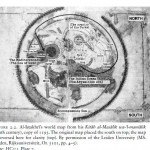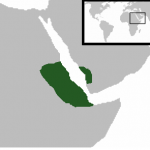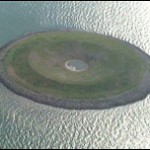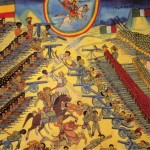Lobasha, A Psychic Boy Detective December 10, 2017
Author: Beach Combing | in : Modern
Had something stolen? A close friend has been murdered? Or has there been a kidnapping in the family? Help unfortunately is not at hand. The FBI are busy with the Patriot Act, the A Team are lost in the Los Angeles Underground and Le Chevalier C. Auguste Dupin is regrettably fictional. However, do not despair for […]
Ethiopian Boat Arrives in the Mediterranean?! November 20, 2014
Author: Beach Combing | in : Medieval
Here’s a strange text to say the least. It appears in that remarkable tenth-century Arab work Meadows of Gold and Mines of Gems by Abu Zayd, the kind of miscellany of marvels that only the Arabs could write: the non-fiction reflex of Sinbad. In the Sea of Rum [the Mediterranean] near the island of Iqritish […]
Roman Adventures in Ethiopia November 13, 2014
Author: Beach Combing | in : Ancient
There is absolutely no doubt that Roman merchants passed down the Red Sea and traded with the Ethiopians. But how exciting when every so often we see more than just coins and broken pots. Here is an account of some Roman Syrians who had visited India in the early fourth century AD (for philosophical purposes!) […]
The Earliest African Unicorn Evidence November 8, 2014
Author: Beach Combing | in : Ancient, Medieval
This blog, several years ago, ran a series of posts on unicorns. Here is a late appendix based on reading Cosmas Indicopleustes’ Christian Topography, a work that dated to the mid sixth century of our era. Cosmas was a widely travelled Greek. He had been to Ethiopia and he may have been to Sri Lanka, […]
Strange Encounter in Ninth-Century Tunisia August 9, 2014
Author: Beach Combing | in : Medieval
In the late ninth century A.D. a curious encounter took place in Islamic Tunisia, an encounter between outsiders. On the one hand, there was the Jewish community of Kairouan, living now under Arab rule, but with its roots stretching back to Roman times and perhaps beyond. On the other, was a foreigner named Eldad Ben […]
A Medieval Phoenix and Heliopolis March 25, 2014
Author: Beach Combing | in : Ancient, Medieval
The phoenix has been written about for well over two thousand years. Here though is a late version, a medieval version, in fact. It is interesting for its vividness and also for the curious confusion over Heliopolis, which the author situates in Ethiopia (rather than Egypt): any help with where this confusion begins, drbeachcombing AT […]
In Search of the Lamia in Ethiopia? January 28, 2014
Author: Beach Combing | in : Modern
This passage appears in an 1863 book about a Briton’s residence in Abyssinia. The author seems to be in two minds about the monster he is describing. Is it real or is it a figment of the locals’ imagination? In the text he seems to account for it as legend, but note that he had […]
Were-Storks and the Origins of Storks’ Baby Carrying! October 26, 2013
Author: Beach Combing | in : Medieval
There is the well established legends of the storks flying, in antiquity down below the Sahara to battle the pygmies. But what about this unusual medieval legend that appears in a fourteenth-century work in two parts. First our author is describing the well-established error, one that survived into the nineteenth century, that certain birds hibernate […]
The Were-Hyenas of Ethiopia June 26, 2011
Author: Beach Combing | in : Modern
In the winter of last year Beachcombing had the werewolf mania bad and before he got bored with the hairy-handed ones he started to make notes on the Buda of Abyssinia, a winsome African lycanthrope. The following text was published in the second quarter of the nineteenth century and was written by a one-time European […]
Iambulus’s Island March 3, 2011
Author: Beach Combing | in : Ancient
**Beachcombing dedicates this post to author and Diodorus scholar Ed Murphy (After the Funeral) who inspired the following** Ancient historian, Diodorus Siculus (obit 1st cent BC) has appeared before on this blog for his description of a mysterious island out in the Atlantic. However, Diodorus, at the end of his second book, also wrote about an […]
Third-Century Indian Coins in Twentieth-Century Ethiopia February 17, 2011
Author: Beach Combing | in : Ancient
In 1940 a thrilling discovery was made at the Ethiopian monastery of Dabra-Dammo in northern Ethiopia. In the remains of a gold encrusted box in the holy house 104 Indian coins were identified. The coins were extremely valuable: the possibility that a practical joker – perhaps an Italian squaddie – brought these across in […]
Image: Holy Adowa! January 22, 2011
Author: Beach Combing | in : Modern
Memo to any budding generals: never invade Russia in the winter, never start a land war in Asia and, most relevant for today, never presume to colonise Ethiopia…Italy unfortunately never learnt this lesson. In 1935 the Italian invasion would mark the beginning of the end for Mussolini’s regime. While in 1896 an Italian attack ended in […]
The Ass Who Became a Saint January 13, 2011
Author: Beach Combing | in : Modern
Yesterday Beachcombing visited the doghead legend of St Christopher and today, in sympathy for that early canine holyman he thought that he would recount the remarkable canonization of an ass. The version that Beachcoming is about to give appears in a rather obscure but very worthwhile book: The Life and Adventures of Nathaniel Pearce (1831) describing the doings of […]


